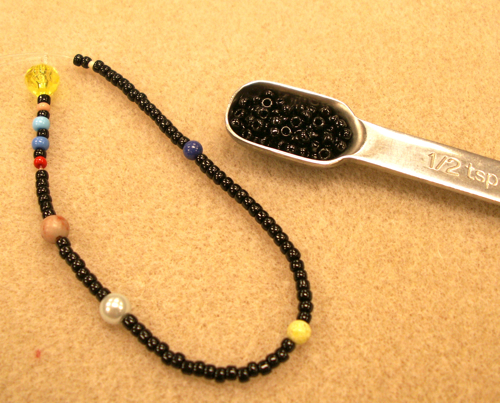

 Constructing a Solar System Bracelet is a GREAT way to introduce students in grades 6-9 to their study of the solar system. My ninth graders loved it! I found out about the activity from former MSTA president, Shirley Greene, who also participated in NASA's Solar System Ambassador Program. Read the instructions below to find out how to do the activity. Constructing a Solar System Bracelet is a GREAT way to introduce students in grades 6-9 to their study of the solar system. My ninth graders loved it! I found out about the activity from former MSTA president, Shirley Greene, who also participated in NASA's Solar System Ambassador Program. Read the instructions below to find out how to do the activity. Although constructing the bracelet makes students more interested in the solar system, like most diagrams and models of the solar system, the bracelet does not accurately depict sizes AND distances. So, it's important to set aside time to help students understand this. CLICK HERE for suggestions. Instructions 1. Set up several stations around the room where students can cut the "Stretch Magic" thread needed to make the bracelets (photo). Students should obtain 12 inches of .5 mm (diameter) durable, elastic thread. Instruct students to tie a very tight knot about an inch from one end of the thread (photo). "Stretch Magic" thread is very difficult to break, so tell them to tie the knot tight! 2. Organize the beads in trays where students can have convenient access to them (photo). Students should use petri dishes (either tops or bottoms) to obtain beads that represent each of the planets. Although it is no longer classified as a planet, a "Pluto bead" will be included to represent the Kuiper Belt Objects (photo). Students should also obtain 1/2 teaspoon of the black, donut-shaped "short spacer beads" (SS) and two black, tube-shaped "long spacer" beads" (LS) (photo). 3. Students will start by placing one of the longer black spacer beads (LS), one of the shorter black spacer beads (SS), and the Sun bead onto the elastic string as shown here (photo). 4. After the Sun bead students should place the rest of the beads onto the string. Write the order on the board for students to see as they string the beads. Remind them that "SS" means "short spacer bead" and "LS" means "long spacer bead" (photo). Tie a knot. - one LS - one SS - Sun - one SS - Mercury - one SS - Venus - one SS - Earth - one SS - Mars - six* SS - Jupiter - eight SS - Saturn - eighteen SS - Uranus - twenty SS - Neptune - sixteen SS - Pluto - at least five** SS and one LS - Tie another very tight knot so that Pluto and the black beads will not fall off (photo). 5. Next students should tie the two ends together as shown here (photo) and bring the bracelet to you so that you (the teacher) can place a drop of super-glue onto the knot (photo). Finally, they can use scissors to trim the excess thread (photo). That's all there is to it! (photo)
*If you would like to include the Asteroid Belt . . .
**For those students with bigger wrists . . .
|

 |
Rodney's Homepage for Earth Science Teachers |
 |
MSTA Web Site |
|
Earth Science Teacher at Helena High School |